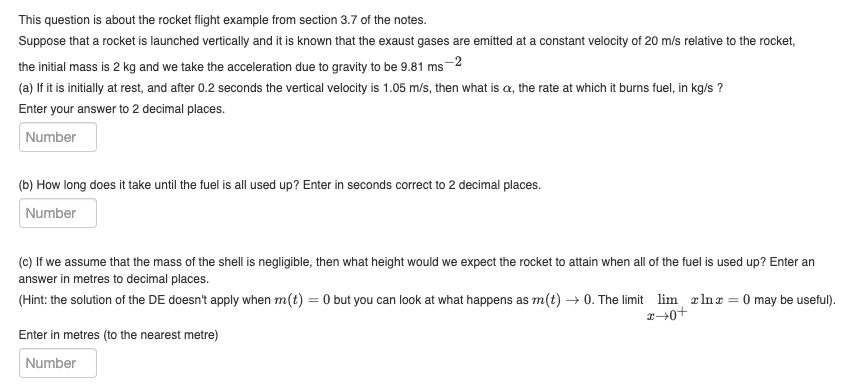This question is about the rocket flight example from section 3.7 of the notes. Suppose that a rocket is launched vertically and it is known that the exaust gases are emitted at a constant velocity of 20 m/s relative to the rocket, the initial mass is 2 kg and we take the acceleration due to gravity to be 9.81 ms-2 (a) If it is initially at rest, and after 0.2 seconds the vertical velocity is 1.05 m/s, then what is a, the rate at which it burns fuel, in kg/s ? Enter your answer to 2 decimal places. Number (b) How long does it take until the fuel is all used up? Enter in seconds correct to 2 decimal places. Number (c) If we assume that the mass of the shell is negligible, then what height would we expect the rocket to attain when all of the fuel is used up? Enter an answer in metres to decimal places. (Hint: the solution of the DE doesn't apply when m(t) = 0 but you can look at what happens as m(t) → 0. The limit lim, lnx = 0 may be useful). Enter in metres (to the nearest metre) Number +0+2
This question is about the rocket flight example from section 3.7 of the notes. Suppose that a rocket is launched vertically and it is known that the exaust gases are emitted at a constant velocity of 20 m/s relative to the rocket, the initial mass is 2 kg and we take the acceleration due to gravity to be 9.81 ms-2 (a) If it is initially at rest, and after 0.2 seconds the vertical velocity is 1.05 m/s, then what is a, the rate at which it burns fuel, in kg/s ? Enter your answer to 2 decimal places. Number (b) How long does it take until the fuel is all used up? Enter in seconds correct to 2 decimal places. Number (c) If we assume that the mass of the shell is negligible, then what height would we expect the rocket to attain when all of the fuel is used up? Enter an answer in metres to decimal places. (Hint: the solution of the DE doesn't apply when m(t) = 0 but you can look at what happens as m(t) → 0. The limit lim, lnx = 0 may be useful). Enter in metres (to the nearest metre) Number +0+2
Classical Dynamics of Particles and Systems
5th Edition
ISBN:9780534408961
Author:Stephen T. Thornton, Jerry B. Marion
Publisher:Stephen T. Thornton, Jerry B. Marion
Chapter9: Dynamics Of A System Of Particles
Section: Chapter Questions
Problem 9.62P
Related questions
Topic Video
Question
Please help me answer this

Transcribed Image Text:This question is about the rocket flight example from section 3.7 of the notes.
Suppose that a rocket is launched vertically and it is known that the exaust gases are emitted at a constant velocity of 20 m/s relative to the rocket,
the initial mass is 2 kg and we take the acceleration due to gravity to be 9.81 ms
s-2
(a) If it is initially at rest, and after 0.2 seconds the vertical velocity is 1.05 m/s, then what is cx, the rate at which it burns fuel, in kg/s ?
Enter your answer to 2 decimal places.
Number
(b) How long does it take until the fuel is all used up? Enter in seconds correct to 2 decimal places.
Number
(c) If we assume that the mass of the shell is negligible, then what height would we expect the rocket to attain when all of the fuel is used up? Enter an
answer in metres to decimal places.
(Hint: the solution of the DE doesn't apply when m(t) = 0 but you can look at what happens as m(t) →0. The limit lim, lnx = 0 may be useful).
Enter in metres (to the nearest metre)
Number
+0+x
Expert Solution
This question has been solved!
Explore an expertly crafted, step-by-step solution for a thorough understanding of key concepts.
Step by step
Solved in 4 steps with 3 images

Knowledge Booster
Learn more about
Need a deep-dive on the concept behind this application? Look no further. Learn more about this topic, physics and related others by exploring similar questions and additional content below.Recommended textbooks for you

Classical Dynamics of Particles and Systems
Physics
ISBN:
9780534408961
Author:
Stephen T. Thornton, Jerry B. Marion
Publisher:
Cengage Learning

Physics for Scientists and Engineers: Foundations…
Physics
ISBN:
9781133939146
Author:
Katz, Debora M.
Publisher:
Cengage Learning

Classical Dynamics of Particles and Systems
Physics
ISBN:
9780534408961
Author:
Stephen T. Thornton, Jerry B. Marion
Publisher:
Cengage Learning

Physics for Scientists and Engineers: Foundations…
Physics
ISBN:
9781133939146
Author:
Katz, Debora M.
Publisher:
Cengage Learning